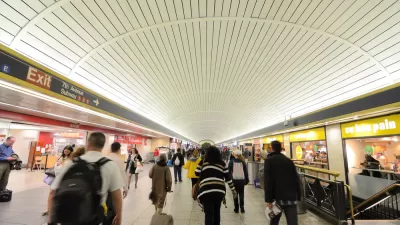Similar to high-speed rail projects throughout the nation, Amtrak will be looking to the private sector to help pay a portion of the expected $20 billion tab to build two new tunnels under the Hudson River and expand New York's Penn Station.
The project "certainly seems to lend itself to some aspect of public-private partnership involvement, particularly in station development," said Drew Galloway, Amtrak's deputy chief of Northeast Corridor Planning and Performance, about the plan known as Gateway Program, write Hilary Russ and Edward Krudy for Reuters.
Private financing would be especially suited to the expansion and revamp of New York's Penn Station, but could also help fund tunnel construction itself, said Galloway
The Gateway Development Corporation, which will be housed within the Port Authority of New York and New Jersey, will be in charge of the project. Amtrak and the U.S. Department of Transportation will pay half the cost, and New York and New Jersey will pay the other half.
The Port Authority is already using public-private partnerships for a $4 billion LaGuardia Airport upgrade and a $1.5 billion revamp of (the Goethals Bridge) linking Staten Island to New Jersey.
According to the Reuters' graphic, the Gateway Program would be the third "largest in the United States using a combination of private and public money" after California high-speed rail and California's Bay Delta Conservation Plan.
Private funding is possible when there is a revenue component to the project, such as toll roads and bridges. "A surcharge on commuter tickets, tolls for freight traffic or facility maintenance payments are possible ways for private sector players to earn back their investments, analysts said," add Russ and Krudy
In other rail projects, private funds are expected to foot most, if not all of the cost of the:
- DesertXpress high-speed rail from Victorville, Calf. to Las Vegas
- Texas Central Railway (high-speed rail from Dallas to Houston)
- All Aboard Florida (125 mph rail from Miami to Orlando)
- Northeast Maglev from Washington to Baltimore
FULL STORY: Tight budgets open $20 billion New York tunnel plan to private cash

Study: Maui’s Plan to Convert Vacation Rentals to Long-Term Housing Could Cause Nearly $1 Billion Economic Loss
The plan would reduce visitor accommodation by 25,% resulting in 1,900 jobs lost.

North Texas Transit Leaders Tout Benefits of TOD for Growing Region
At a summit focused on transit-oriented development, policymakers discussed how North Texas’ expanded light rail system can serve as a tool for economic growth.

Why Should We Subsidize Public Transportation?
Many public transit agencies face financial stress due to rising costs, declining fare revenue, and declining subsidies. Transit advocates must provide a strong business case for increasing public transit funding.

How to Make US Trains Faster
Changes to boarding platforms and a switch to electric trains could improve U.S. passenger rail service without the added cost of high-speed rail.

Columbia’s Revitalized ‘Loop’ Is a Hub for Local Entrepreneurs
A focus on small businesses is helping a commercial corridor in Columbia, Missouri thrive.

Invasive Insect Threatens Minnesota’s Ash Forests
The Emerald Ash Borer is a rapidly spreading invasive pest threatening Minnesota’s ash trees, and homeowners are encouraged to plant diverse replacement species, avoid moving ash firewood, and monitor for signs of infestation.
Urban Design for Planners 1: Software Tools
This six-course series explores essential urban design concepts using open source software and equips planners with the tools they need to participate fully in the urban design process.
Planning for Universal Design
Learn the tools for implementing Universal Design in planning regulations.
City of Santa Clarita
Ascent Environmental
Institute for Housing and Urban Development Studies (IHS)
City of Grandview
Harvard GSD Executive Education
Toledo-Lucas County Plan Commissions
Salt Lake City
NYU Wagner Graduate School of Public Service



























